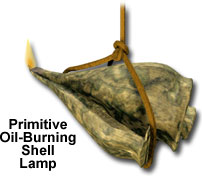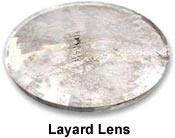
|
Prehistory to 999 AD
The earliest human experiences with light and optics were of the natural world; sunlight, fire, and the reflective and refractive (light bending) properties of water, crystals, and other naturally occurring substances. Fire was one of the first tools utilized by ancestors of modern humans, perhaps as early as 1.4 million years ago, but it probably was not used for nighttime illumination until 500,000 years ago. By 15,000 years ago, people were burning fat and oil in lamps to illuminate the dark, the first artificial devices for creating light.

Archeological findings from early cultures, made by Austen Layard in the nineteenth century, indicate that by 3,000 BC people in the Middle East, Africa, and Asia were becoming increasingly aware of optical phenomena and were using them for a variety of purposes. Shadows were used for theatrical entertainment. Metals and crystals were modified and shaped to exploit their reflective and refractive properties for use as decoration and as jewelry. The invention of glass around this time was probably fueled by its remarkable optical properties. The oldest glass artifacts are glass beads that were obviously used as jewelry.
By 300 BC, Greek scholars had begun to study and contemplate optical phenomena in earnest, generating theories to explain vision, color, light, and astronomical phenomena. Many of those theories turned out to be wrong, but they did serve to inaugurate the science of optics. Plato is believed to be the first person to articulate the emission theory of vision. This theory, which prevailed until the second millennium AD, suggested that the eyes projected rays of light, like a flashlight, illuminating objects in front of them. When something blocked the "eye-rays," the result was darkness.

In the western world, Euclid of Alexandria made the first recorded observations concerning optics and light. He wrote an in-depth study of the phenomenon of visible light in his work Optica, where he defined the laws of reflection of light from smooth surfaces. Aristotle also studied the nature of vision, but disagreed with the theory that rays emanated from the eyes. Also during this time period, the great Sicilian mathematician Archimedes studied reflection and refraction, but his work was destroyed when the Romans sacked Syracuse.
The idea for the camera obscura, the ancestor of the camera, most likely originated in early Greece. It is essentially a pinhole camera in which light passes through a small hole and is projected in a darkened room or box, generally without the aid of a lens. For hundreds of years, scientists used the camera obscura to view solar eclipses without damaging their eyes, and it is still utilized for that purpose in modern times by amateur scientists and the general public.
The Romans did little to advance the science of optics, although Seneca, a tutor and favored friend of Roman Emperor Nero, noted the magnifying effects of liquids in transparent vessels. Nero is reported to have used a smooth emerald lens to better observe gladiators in combat.
During the second century AD, Ptolemy, a Greek astronomer based in Alexandria, Egypt, studied and wrote about many topics in science. Most notable was his development of the geocentric, or Earth-centered, theory of the solar system that would prevail for over a thousand years. He published five books about optics, but only one book has survived to the modern era. This series of works was dedicated to the study of color, reflection, refraction, and mirrors of various shapes. The establishment of theory by experiment, frequently supported by the construction of special apparatus, is the most striking feature of Ptolemy's Optics.
Few other advances were made in optics until after 1000 AD. However, the Arab scholar Alhazan, a.k.a. Abu Ali Hasan Ibn al-Haitham, conducted the first serious study of lenses in Basra (Iraq). He studied refraction in lenses, disproving Ptolemy's law of refraction, and also carried out research on reflections from spherical and parabolic mirrors. His writings were the first to explain vision correctly, as a phenomenon of light coming into the eye, rather than the eye emitting light rays.
| Prehistory to 999 AD |
| 1.4 million BC |
Earliest evidence for controlled use of fire by prehistoric humans. |
| 12,000 BC |
Earliest known use of oil burning lamps. |
| 3,000 BC |
Middle Eastern and Asian cultures begin to study light and shadow and probably exploit their properties for entertainment. Asian cultures are making and using mirrors. |
| 900-600 BC |
The Babylonians make convex lenses from crystals, but since they have poor magnifying qualities, they were probably used more for ornamentation or as curiosities. |
| 423 BC |
Greek writer Aristophanes writes a comedy, Clouds, in which a character uses an object to reflect and concentrate the sun's rays, melting an IOU recorded on a wax tablet. |
| 400-300 BC |
Greek scholars speculate about light and optics:
Plato proposes that the soul is the source of vision, with light rays emanating from the eyes and illuminating objects.
Democritus makes the first attempt to explain perception and color in terms of the size, shape, and "roughness" of atoms.
Euclid publishes Optica, in which he defines the law of reflection and states that light travels in straight lines.
Aristotle speculates about perception, but rejects the theory about human vision emanating as light rays from the eyes. |
| 280 BC |
The Egyptians complete construction of the world's first lighthouse, Pharos of Alexandria, one of the Seven Wonders of the World and the archetype of all future lighthouses. |
250 BC-
100 AD |
The Chinese are perhaps the first to use optical lenses and the first documented case of a corrective lens occurs around this time. Magician Shao Ong invents "shadow plays," in which puppet shadows are cast onto thin screens. The first Roman shadow plays are written by poet and naturalist Lucretius around 65 BC.
Roman philosopher Seneca describes the magnification of objects seen through transparent globes filled with water.
Nero Claudius Caesar, Emperor of Rome, uses a faceted emerald to correct his near-sightedness to watch gladiators in the arena. Later excavations at Pompeii and Herculaneum will yield several glass-crystal lenses from this period.
Hero (Alexandria) publishes a work entitled Catoptrica (Reflections) and demonstrates that the angle of reflected light is equal to the angle of incidence. |
| 100-950 AD |
Claudius Ptolemy (Alexandria) is the first person on record to collect and publish experimental data on optics. He promotes the concept that vision emanates from the eyes and that the sun revolves around the Earth.
Chinese scientist Ting Huan discovers apparent movement seen through convection currents of hot air generated by a lamp around 180 AD, and Greek physicist Galen begins studying binocular vision during the same period.
In 525 AD, Roman scholar and mathematician Anicus Boethius attempts to document the speed of light, but is decapitated for his efforts after being accused of treason and magic.
Arabian alchemist Gerber observes the darkening effect of bright light on silver nitrate around 750 AD. During the next two hundred years, both Arab and Chinese scientists observe eclipses using the camera obscura effect. In the 10th century, Yu Chao Lung builds miniature pagodas designed to observe pinhole images projected onto a screen, demonstrating the divergence of light rays after passing through the pinhole. |
| 999 AD |
Alhazen, also known as Abu Ali Hasan Ibn al-Haitham (present-day Iraq), used spherical and parabolic mirrors to study spherical aberration and gives the first accurate account of vision--that the eyes receive light, rather than transmit it. Alhazen also investigated magnification resulting from atmospheric refraction and writes about the anatomy of the human eye and describes how the lens forms an image on the retina in his famous major optical work "Opticae Thesaurus" (Opticae thesaurus Alhazeni libri vii), the first real contribution to the the science of optics in the first millennium. He used the camera obscura effect in the study of eclipses, and notes that images appear clearer when the pinhole size is reduced. |
|
|
 |
 |
 |
BACK TO TIMELINE IN OPTICS HOME
Questions or comments? Send us an email.
© 1995-2025 by
Michael W. Davidson
and The Florida State University.
All Rights Reserved. No images, graphics, software, scripts, or applets may be reproduced or used in any manner without permission from the copyright holders. Use of this website means you agree to all of the Legal Terms and Conditions set forth by the owners.
This website is maintained by our
Graphics & Web Programming Team
in collaboration with Optical Microscopy at the
National High Magnetic Field Laboratory.
Last Modification Friday, Nov 13, 2015 at 01:18 PM
Access Count Since August 1, 2000: 86071
Visit the websites of our partners in education:
|


